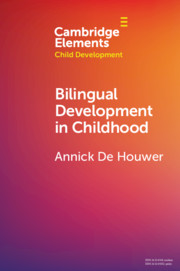Element contents
Bilingual Development in Childhood
Published online by Cambridge University Press: 19 April 2021
Summary
- Type
- Element
- Information
- Series: Elements in Child DevelopmentOnline ISBN: 9781108866002Publisher: Cambridge University PressPrint publication: 13 May 2021
References
- 61
- Cited by

